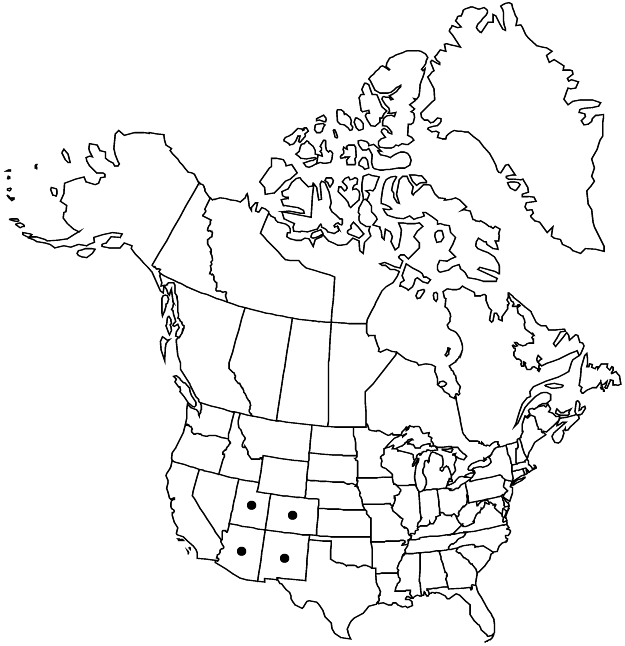Eriogonum leptophyllum
Contr. U.S. Natl. Herb. 16: 118. 1913.
Shrubs or subshrubs, rounded to spreading, not scapose, (0.5–)2–8(–13) × (1–)3–15(–18) dm, thinly pubescent or glabrous and green, yellowish green or infrequently grayish, occasionally papillate. Stems spreading, without persistent leaf bases, up to 1/3 height of plant; caudex stems absent or compact; aerial flowering stems spreading, slender, solid, not fistulose, (0.05–)0.1–0.8 dm, thinly pubescent or glabrous. Leaves cauline, 1 per node or fasciculate; petiole 0.05–0.1 cm, tomentose to floccose or glabrous; blade linear to linear-oblanceolate, (0.5–)2–6 × (0.03–)0.1–0.3 cm, densely to thinly white-tomentose abaxially, thinly so or glabrous and green adaxially, margins tightly revolute. Inflorescences cymose, usually compact, (0.1–)2–12(–15) × (1–)4–15(–30) cm; branches dichotomous, thinly pubescent or glabrous; bracts 3, scalelike, triangular, (0.5–)1–4 mm. Peduncles absent or erect, 0.05–0.2 cm, glabrous. Involucres 1 per node, narrowly turbinate, 2–4(–4.5) × 1–2 mm, glabrous; teeth 5, erect, 0.3–0.7 mm. Flowers 2.5–4 mm; perianth white, glabrous; tepals connate proximal 1/4, essentially monomorphic, oblong to narrowly obovate; stamens long-exserted, (2–)3–6 mm; filaments subglabrous or sparsely puberulent proximally. Achenes brown, (2.5–)3.5–4 mm, glabrous. 2n = 40.
Phenology: Flowering Jul–Nov.
Habitat: Clayey flats, slopes, and outcrops, mixed grassland and sagebrush communities, pinyon-juniper woodlands
Elevation: 1500-2300 m
Distribution

Ariz., Colo., N.Mex., Utah.
Discussion
Eriogonum leptophyllum is found mainly on southern Colorado Plateau in San Juan County, Utah, and adjacent Montezuma County, Colorado, southward into Apache County, Arizona, and in northwestern New Mexico (Bernalillo, Cibola, McKinley, Rio Arriba, Sandoval, San Juan, Santa Fe, and Taos counties). The species is found rarely in eastern Coconino and Navajo counties, Arizona, in the north, and in northern Gila County, Arizona, to the south. It is disjunct to the Bitter Spring Creek area of Capitol Reef National Park in Garfield County, Utah (R. Fleming 199, SJNM). The species, when dwarfed as it sometimes is on wind-swept ridges, resembles E. microthecum var. simpsonii, and has a form and aspect much more typical of that species than of the large, mature plants of E. leptophyllum. Mature plants on the southern edge of the range (as in McKinley County) tend to be grayish rather than the more common yellowish green seen elsewhere.
This species is considered a “life medicine” by the Navajo (Diné) people (C. Arnold, pers. comm.), being used in a variety of ways, including as an analgesic, a gynecological aid, a snake-bite remedy (D. E. Moerman 1986), and in casting spells (Arnold Clifford, pers. comm.). P. A. Vestal (1952) listed similar uses of this species by the Ramah Navajo of northwestern New Mexico, including an infusion of roots for stomach trouble, a decoction of the whole plant for snake bite, and for postpartum pain. The species is cultivated occasionally as a horticultural novelty.
There are two anomalous populations of particular interest. These occurred in the Broomfield area of San Juan County, New Mexico. The specimens are of low, spreading herbs to 0.8 dm with linear-oblong leaf blades 1–2 cm long but only 1–2 mm wide. The inflorescences are cymose but typically with one branch suppressed. A peduncle is present in some, this being up to 3.5 mm and erect; it is always at the basal node of the inflorescence. The involucres are turbinate and long (4–6 mm). A mature achene has not been observed. The plants flowered in late May and early June. Efforts to find such plants again have been unsuccessful. Searches in the late summer and early fall, when they ought to be in fruit, have found only plants that clearly can be assigned to Eriogonum leptophyllum. Generally, the two anomalous collections, both made by J. Mark Porter in the 1980s, resemble that species. Until such odd plants can be found again, and studied in detail, the significance of those populations cannot be ascertained.
Selected References
None.